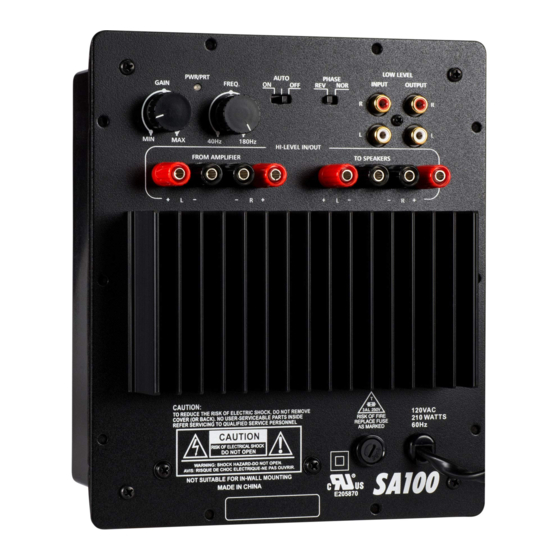DaytonAudio SA100 Manuale d'uso - Pagina 3
Sfoglia online o scarica il pdf Manuale d'uso per Amplificatore DaytonAudio SA100. DaytonAudio SA100 4. 100 watt subwoofer plate amplifier

All manuals and user guides at all-guides.com
INPUT/OUTPUT CONNECTIONS
1.) Low-Level Inputs (Left/Right)
RCA style jacks that will accept standard line level inputs from a pre-amp level source. They will accept a stereo signal and inter-
nally combine it into mono. (Note: Both left and right input jacks must be connected to the source in order to drive the amplifier
to full output).
2.) Low-Level Outputs (Left/Right)
This output allows the low level input signal to be daisy chained to other amplifiers. The low level input is simply passed through
with no alteration (EQ) to the original signal.
3.) High-Level Inputs
Speaker level inputs using binding post type jacks to permit connection with banana plugs or bare wire. Allows the user to connect
the speaker level output of a full range amplifier to the input of the subwoofer amp using standard speaker wire. A mono signal
is derived from the stereo input, which then feeds the subwoofer amplifier crossover input.
4.) High-Level Outputs
Speaker level passthrough outputs using spring clip type jacks to permit connection with bare wire. Used to connect from the
subwoofer amp to pass signal from the full range amp on to the main L/R speakers. Signal is only present on this output if the
high level input is also used. The signal to the L/R speakers is shaped by an internal 6 dB/octave 125 Hz high pass filter. The
impedance "seen" by the full-range source amplifier will be that of the connected speakers only.
5.) Power input
This unit features a hardwired AC power cable and externally-accessible fuse. It is supplied with a 3AL, 250V fuse and USA type
polarized 2-pin plug. This unit is not suitable for 230V applications.
6.) Output Lead for Subwoofer Driver:
This rear mounted output lead connects the amplifier to the subwoofer driver. The output lead is roughly 18" long and is color
coded. The red wire uses an insulated .250" quick disconnect and the black wire uses an insulated .205" quick disconnect. These
connectors can be easily removed if your driver requires another size or type of connector. Be sure to observe proper polarity
when connecting the amplifier to your subwoofer driver (red = positive, black = negative).
CONTROLS/INDICATORS
7.) Gain Knob ("Gain")
This control will match the amplifier's input sensitivity to the output of the pre-amp source. If the source output has a variable
control, we recommend that the user spend a moment or two determining the best balance between the two controls. When a
balance is found between low noise, linear level control, and sufficient level to drive the amp to the required output, the gain knob
can be considered to be the "volume control" for the subwoofer system.
8.) Frequency Knob ("Freq")
This control is used to establish the highest frequency that the subwoofer will reproduce and has a range between 60 to 180 Hz
with a slope of 24 dB per octave. If you are using the system for music and your main speakers have good bass capability, you
could set the control to a fairly low value, often between 60 and 100 Hz. If the main speakers are smaller or do not have much
bass output, set the control higher. Experiment with the amount of "overlap" that you will experience when all speakers are play-
ing in the same range. This can be helpful when integrating the subwoofer with the rest of the system and with the room. Note:
When using the amp with a LFE (Low Frequency Effects) output on a pre-amp or home theatre receiver the internal low pass
filter circuitry should be bypassed by turning the frequency control to maximum (180Hz). The home theater receiver should be
used to control the low pass crossover frequency.
9.) Power LED
When the power switch is moved to the "on" position, the LED will illuminate green, and the amp will be in "On" mode. When set
in the "Auto" position the unit will be in the stand by mode. In this position, if a low level signal of about 10 millivolts or greater is
applied to the input, the light will change green to indicate that the amplifier is fully operational and receiving typical music pro-
gram. If an input signal is not detected for 10 to 15 minutes, the amp will go back to "stand by" mode and the LED will turn off. If
the protection circuit detects a short circuit or thermal overload the unit will shut down and the LED will turn red.
10.) Power Switch
On, Off and Auto mode. When the "Auto" position is selected, the amp is in "stand by" mode until an input signal of about 10 mil-
livolts or greater is detected. The amp will go back to standby mode 10-15 minutes after the input signal stops.
11.) Phase
This two-position (NOR = 0° phase and REV = 180° phase) switch helps to compensate for differences in the acoustical and
electrical characteristics between the subwoofer and the main system speakers. The relative locations of speakers in the system
can cause significant disturbances in speaker interaction due to time delay issues, or the destructive phase interferences that
can occur at certain frequencies. The use of this switch in conjunction with altering the location of the subwoofer can dramatically
improve system integration. The "NOR" setting would be considered the normal or default setting, but be sure to experiment dur-
ing system set-up.
(3)
